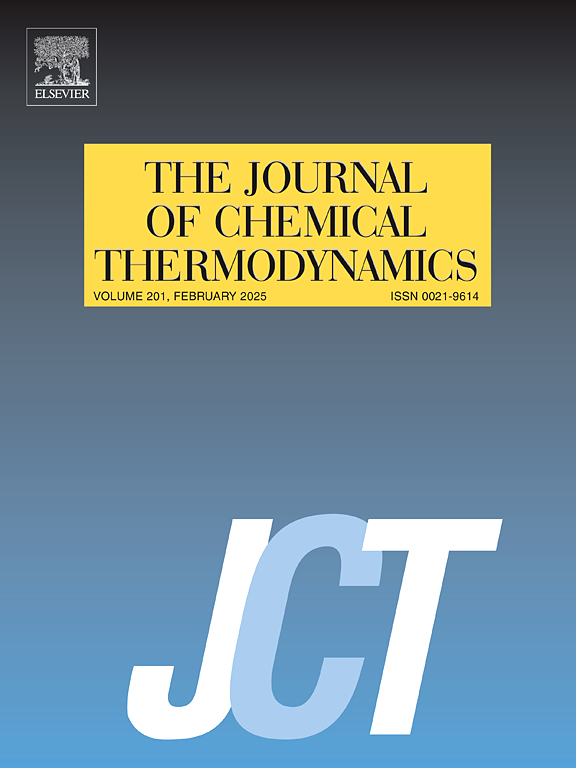Solubility determination and correlation, solvent effect and thermodynamics of itraconazole in sixteen mono solvents and ternary mixtures of N-methyl-2-pyrrolidone, diethylene glycol monoethyl ether, and ethanol
IF 2.2
3区 工程技术
Q3 CHEMISTRY, PHYSICAL
引用次数: 0
Abstract
In this study, the experimental mole fraction solubility of itraconazole in 16 mono solvents (acetone, acetonitrile, 1-butanol, chloroform, DEGME, dichloromethane, DMA, DMF, DMSO, ethanol, methanol, NMP. 1-propanol, 2-propanol, tetrahydrofuran, and water) and ternary solvent system (NMP + DEGME + ethanol) was determined using the well-known shake-flask technique. The rank order of solubility of itraconazole in sixteen mono solvents at 298.15 K is as follows: chloroform (5.04 × 10−2) > dichloromethane (3.27 × 10−2) > NMP (2.20 × 10−2) > DMA (1.18 × 10−2) > DMF (1.07 × 10−2) > tetrahydrofuran (2.12 × 10−3) > DMSO (1.75 × 10−3) > DEGME (7.30 × 10−4) > acetone (6.37 × 10−4) > acetonitrile (7.95 × 10−5) > methanol (3.79 × 10−5) > 1-butanol (2.30 × 10−5) > 2- propanol (2.14 × 10−5) > 1-propanol (2.05 × 10−5) > ethanol (1.91 × 10−5) > water (2.43 × 10−7). According to the regression results of the KAT-LSER model, the solubility of itraconazole was principally affected by dipolarity/polarizability and solvent–solvent interaction. The mole fraction solubility of itraconazole increased with the increasing temperature and mass fraction of NMP in the ternary mixtures (NMP + DEGME + ethanol). In addition, the solubility parameters were applied to comprehensively understand and describe the solubility of itraconazole in a ternary solvent system. Four thermodynamic models, including van’t Hoff model, modified Apelblat model, Jouyban–Acree model, and Jouyban–Acree–van’t Hoff model, were used to fit the solubility data of itraconazole. The thermodynamic properties of itraconazole during the dissolution processes were estimated using the Gibbs equation and modified van’t Hoff analysis. The solid–liquid equilibrium solubility in sixteen different mono solvents and ternary solvent systems, solvent effect on the solubility, four correlation models, and thermodynamic properties could be helpful for pre-formulation study, extraction, purification, crystallization, and development of liquid formulation, including topical solution.
伊曲康唑在n -甲基-2-吡咯烷酮、二乙二醇单乙醚和乙醇的16种单溶剂和三元混合物中的溶解度测定、相关性、溶剂效应和热力学
本研究实验了伊曲康唑在16种单溶剂(丙酮、乙腈、1-丁醇、氯仿、DEGME、二氯甲烷、DMA、DMF、DMSO、乙醇、甲醇、NMP)中的摩尔分数溶解度。1-丙醇、2-丙醇、四氢呋喃和水)和三元溶剂体系(NMP + DEGME +乙醇)采用著名的摇瓶技术进行测定。在298.15 K下,伊曲康唑在16种单溶剂中的溶解度等级为:氯仿(5.04 × 10−2)>;二氯甲烷(3.27 × 10−2);NMP (2.20 × 10−2)>;DMA (1.18 × 10−2)>;DMF (1.07 × 10−2)>;四氢呋喃(2.12 × 10−3);DMSO (1.75 × 10−3)>;DEGME (7.30 × 10−4)>;丙酮(6.37 × 10−4)>;乙腈(7.95 × 10−5);甲醇(3.79 × 10−5);-丁醇(2.30 × 10−5)>;2-丙醇(2.14 × 10−5)>;1-丙醇(2.05 × 10−5)>;乙醇(1.91 × 10−5)>;水(2.43 × 10−7)。根据KAT-LSER模型的回归结果,伊曲康唑的溶解度主要受双极性/极化性和溶剂-溶剂相互作用的影响。在三元混合物(NMP + DEGME +乙醇)中,随着温度的升高和NMP质量分数的增加,伊曲康唑的摩尔分数溶解度增加。此外,还应用溶解度参数全面了解和描述了伊曲康唑在三元溶剂体系中的溶解度。采用van 't Hoff模型、修正Apelblat模型、Jouyban-Acree模型和Jouyban-Acree - van 't Hoff模型对伊曲康唑的溶解度数据进行拟合。利用Gibbs方程和修正的van 't Hoff分析估计了伊曲康唑在溶解过程中的热力学性质。十六种不同的单溶剂和三元溶剂体系的固液平衡溶解度、溶剂对溶解度的影响、四种相关模型和热力学性质可为配方前研究、提取、纯化、结晶和液体制剂(包括外用溶液)的开发提供帮助。
本文章由计算机程序翻译,如有差异,请以英文原文为准。
求助全文
约1分钟内获得全文
求助全文
来源期刊

Journal of Chemical Thermodynamics
工程技术-热力学
CiteScore
5.60
自引率
15.40%
发文量
199
审稿时长
79 days
期刊介绍:
The Journal of Chemical Thermodynamics exists primarily for dissemination of significant new knowledge in experimental equilibrium thermodynamics and transport properties of chemical systems. The defining attributes of The Journal are the quality and relevance of the papers published.
The Journal publishes work relating to gases, liquids, solids, polymers, mixtures, solutions and interfaces. Studies on systems with variability, such as biological or bio-based materials, gas hydrates, among others, will also be considered provided these are well characterized and reproducible where possible. Experimental methods should be described in sufficient detail to allow critical assessment of the accuracy claimed.
Authors are encouraged to provide physical or chemical interpretations of the results. Articles can contain modelling sections providing representations of data or molecular insights into the properties or transformations studied. Theoretical papers on chemical thermodynamics using molecular theory or modelling are also considered.
The Journal welcomes review articles in the field of chemical thermodynamics but prospective authors should first consult one of the Editors concerning the suitability of the proposed review.
Contributions of a routine nature or reporting on uncharacterised materials are not accepted.
 求助内容:
求助内容: 应助结果提醒方式:
应助结果提醒方式:


